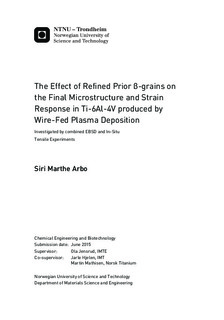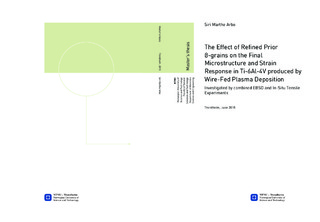| dc.description.abstract | In this master thesis, the focus has been on a Ti-6Al-4V specimen produced by Norsk Titanium s patented wire-fed plasma deposition technique, under conditions promoting the break up of the traditional large columnar β-grains formed during solidification. Both the final microstructure and strain response have been studied using several different experimental techniques, such as heat tinting, light microscopy and electron backscatter diffraction, EBSD combined with In-Situ tensile experiments.
The Ti-6Al-4V specimen studied in this thesis consisted of several deposited layers, and each individual layer contained several small prior β-grains formed during solidification. This resulted in a microstructure with a large area covered with prior β-grain boundaries, which at room temperature was covered with grain boundary α. α-colonies was frequently observed growing from the grain boundary α, resulting in a microstructure more dominated by α-colony morphology compared to the traditional reported microstructure. The small prior β-grains found in this material did not seem to affect the thickness of the final α-plates at room temperature. However, the size of the prior β-grains was frequently observed to affect the final microstructural morphology found in the grain.
Several In-Situ tensile tests were performed on specimens having either the deposition direction (Sample X) or build direction parallel (Sample Z) with the tensile direction. The observed deformation was located along the boundaries of the prior β-grains in all specimens. Inhomogeneous deformation of the samples with the build direction parallel with the tensile direction was observed after the deformed samples had been heat tinted, revealing the macro deformation. Due to the unique solidification morphology in each deposited layer, each layer was observed to deform independently during straining in the specimens from Sample Z.
The observed deformation mechanism consisted of slip in both the Prismatic and Basal slip system. The orientation of the crystal structure of a α-colony has proven to be very influential on the deformation and the hard/soft -grain combination was frequently observed where most of the deformation took place. | |

